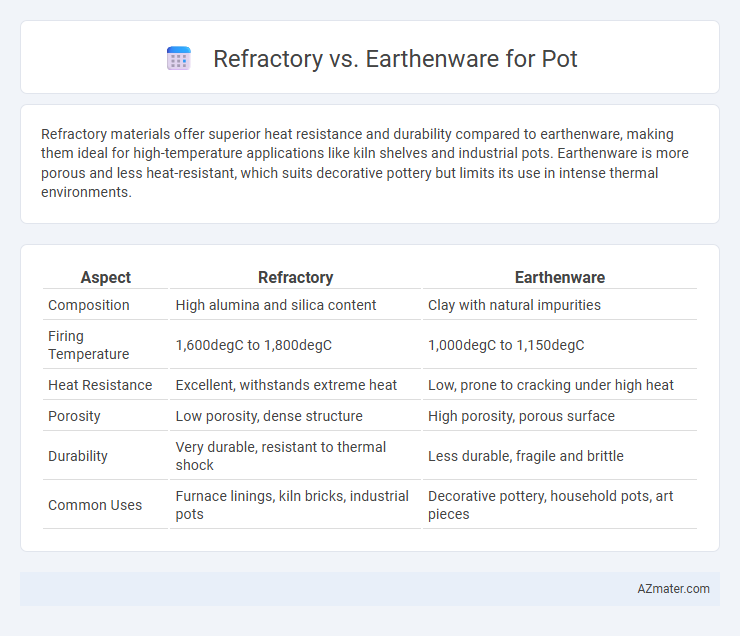Refractory materials offer superior heat resistance and durability compared to earthenware, making them ideal for high-temperature applications like kiln shelves and industrial pots. Earthenware is more porous and less heat-resistant, which suits decorative pottery but limits its use in intense thermal environments.
Table of Comparison
| Aspect | Refractory | Earthenware |
|---|---|---|
| Composition | High alumina and silica content | Clay with natural impurities |
| Firing Temperature | 1,600degC to 1,800degC | 1,000degC to 1,150degC |
| Heat Resistance | Excellent, withstands extreme heat | Low, prone to cracking under high heat |
| Porosity | Low porosity, dense structure | High porosity, porous surface |
| Durability | Very durable, resistant to thermal shock | Less durable, fragile and brittle |
| Common Uses | Furnace linings, kiln bricks, industrial pots | Decorative pottery, household pots, art pieces |
Introduction to Refractory and Earthenware Pots
Refractory pots are crafted from heat-resistant materials, ideal for high-temperature applications such as metal casting or kiln use, offering durability and thermal shock resistance. Earthenware pots, made from porous clay fired at lower temperatures, are commonly used for plants and cooking due to their breathability and aesthetic appeal. Understanding the distinct thermal properties and intended uses of refractory and earthenware pots helps in selecting the right pot for specific heat exposure and structural requirements.
Defining Refractory Materials
Refractory materials are specially designed to withstand high temperatures without melting or breaking down, making them ideal for applications like kiln linings and high-heat cooking pots. Compared to earthenware, which is porous and fired at lower temperatures, refractory materials exhibit superior thermal shock resistance and durability. These properties allow refractory pots to endure extreme heating cycles and prolonged exposure to heat, unlike earthenware that is more prone to cracking under intense heat.
What is Earthenware?
Earthenware is a porous, non-vitreous pottery clay fired at lower temperatures between 1,000 and 1,150degC, resulting in a softer, more fragile pot compared to refractory materials. It is ideal for decorative pots and planters but requires glazing to hold water due to its porous nature. These characteristics differentiate earthenware from refractory ceramics, which are designed to withstand higher temperatures and thermal shock, making them suitable for heat-intensive applications.
Key Differences in Composition
Refractory pots are made from high-temperature-resistant materials such as fireclay, alumina, and silica, which enable them to withstand extreme heat without cracking or deforming. Earthenware pots, by contrast, are crafted from porous clay fired at lower temperatures, resulting in a more fragile structure that is less heat-resistant but ideal for decorative or low-heat cooking purposes. The primary composition difference lies in the mineral content and firing temperature, directly influencing durability, thermal conductivity, and suitability for various culinary applications.
Heat Resistance and Thermal Performance
Refractory pots, made from high-quality fireclay, exhibit superior heat resistance and can withstand temperatures above 2500degF, making them ideal for high-heat cooking and industrial applications. Earthenware pots, composed of porous clay fired at lower temperatures (around 1000-1150degC), have moderate thermal performance but are more susceptible to thermal shock and cracking under rapid temperature changes. The dense, vitrified structure of refractory materials ensures enhanced durability and consistent heat retention compared to the more brittle and less heat-tolerant earthenware.
Durability and Lifespan Comparison
Refractory pots, made from high-temperature resistant materials such as fireclay or alumina, offer superior durability and can withstand extreme heat without cracking, making them ideal for prolonged use in kilns or grills. Earthenware pots, composed of porous clay fired at lower temperatures, are more fragile and prone to chipping or breaking, resulting in a shorter lifespan under heavy thermal stress. The enhanced thermal shock resistance and density of refractory pots contribute significantly to their longer lifespan compared to the more delicate and porous structure of earthenware.
Applications in Pottery and Cooking
Refractory materials, such as fireclay and chamotte, are ideal for high-temperature applications in pottery and cooking due to their ability to withstand extreme heat without cracking or deforming, making them suitable for kiln linings, ovenware, and industrial crucibles. Earthenware, composed primarily of porous clay fired at lower temperatures, is commonly used for decorative pottery, tableware, and slow-cooking pots, offering aesthetic appeal and thermal insulation but requiring glazing to ensure durability and food safety. The choice between refractory and earthenware depends on the required thermal resistance and functional use, with refractory ceramics excelling in durability for high-heat cooking, while earthenware suits everyday kitchen use with moderate heat exposure.
Aesthetic Qualities and Finishes
Refractory pots exhibit a smooth, often glossy finish that enhances their modern aesthetic appeal, with colors ranging from muted earth tones to vibrant glazes. Earthenware pots, characterized by a porous surface and matte texture, offer a rustic, natural look with warm, earthy colors that develop a patina over time. The choice between refractory and earthenware ultimately depends on desired visual impact and surface durability in specific decorative settings.
Cost and Accessibility Factors
Refractory pots typically cost more due to their specialized heat-resistant materials, making them less accessible for casual users or hobbyists. Earthenware pots, crafted from natural clay, are generally more affordable and widely available in local markets and craft stores. The cost-effectiveness and accessibility of earthenware make it a preferred choice for everyday cooking, while refractory pots serve better in high-temperature or industrial applications.
Choosing the Right Pot Material
Refractory pots offer superior heat resistance and durability, making them ideal for high-temperature cooking and outdoor use, while earthenware pots excel in moisture retention and slow, even heat distribution, perfect for simmering stews and traditional recipes. Choosing the right pot material depends on cooking style, temperature requirements, and desired flavor enhancement, with refractory suited for grilling and baking, and earthenware for gentle, moist heat cooking. Consider factors like thermal conductivity, porosity, and maintenance needs to ensure optimal performance and longevity of your cookware.

Infographic: Refractory vs Earthenware for Pot
 azmater.com
azmater.com